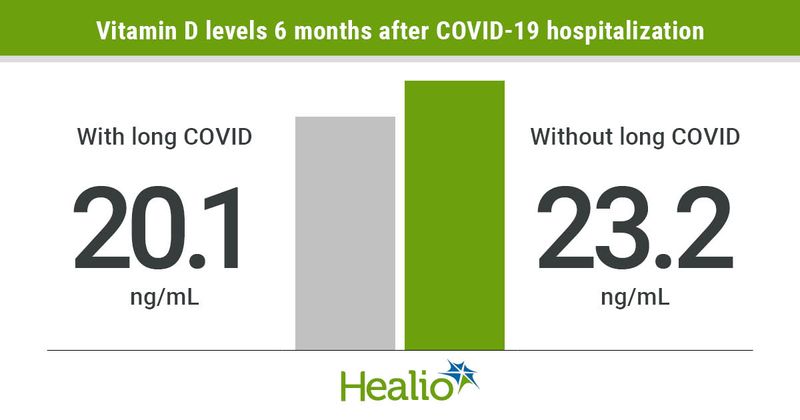Low vitamin D levels observed among adults with long COVID 6 months post-infection
Key takeaways:
- Among adults hospitalized for COVID-19, those with long COVID have lower vitamin D levels at 6 months than adults without long COVID.
- Low vitamin D is associated with a 9% higher likelihood for long COVID.
Adults diagnosed with COVID-19 who had long COVID at a 6-month follow-up had lower vitamin D levels than COVID-19 survivors without long COVID, according to data published in The Journal of Clinical Endocrinology & Metabolism.

“Our study shows that lower circulating vitamin D appears to be an independent risk factor for long COVID occurrence,” Andrea Giustina, MD, professor of endocrinology at Vita-Salute University San Raffaele in Milan, told Healio. “The importance of this finding is increased by the fact that a low circulating vitamin D level is a modifiable risk factor. On the basis of our results, it seems appropriate to check vitamin D levels in COVID-19 survivors.”

Giustina and colleagues conducted an observational retrospective study of 100 adults diagnosed with COVID-19 who were hospitalized at San Raffaele Hospital in Milan from March to May 2020 and attended a follow-up 6 months after discharge from Aug. 31 to Nov. 30, 2020 (median age, 61 years; 56% men). The study cohort included only adults who did not have comorbidities influencing vitamin D metabolism, adults who were not admitted to the ICU and those who had blood samples with vitamin D measurements available at hospitalization and follow-up. Fifty adults with long COVID matched by age, sex, comorbidities and previous COVID-19 severity with 50 adults who did not have long COVID at follow-up. Long COVID was defined as the concomitant presence of two or more symptoms at follow-up that could not be explained by an alternative diagnosis and could only be attributed to previous COVID-19 infection. Data were obtained from patient interviews and medical chart reviews. A complete physical examination was conducted at follow-up.
Among those with long COVID, 19% had asthenia, 17% had dysgeusia and 17% had dyspnea. Constitutional and cardiorespiratory health was affected in 21% of those with long COVID, 18% had their senses affected and 7% experienced effects in neurocognitive areas.
In the full cohort, median 25-hydroxyvitamin D levels were 14.7 ng/mL at hospitalization and 20.6 ng/mL at follow-up. Vitamin D deficiency was observed in 71% of participants at admission and in 46% at 6 months. At follow-up, adults with long COVID had lower vitamin D levels than those without long COVID (20.1 ng/mL vs. 23.2 ng/mL; P = .03). There was no difference between the groups in the prevalence of adults with vitamin D deficiency.
Among adults with vitamin D deficiency at both hospitalization and follow-up, those with long COVID had a lower vitamin D level than adults without long COVID (12.7 ng/mL vs. 15.2 ng/mL; P = .041). Adults with vitamin D deficiency at both time points and constitutional symptoms at 6 months had lower vitamin D levels than those without constitutional symptoms (11.7 ng/mL vs. 15.2 ng/mL; P = .025) and those with asthenia had lower vitamin D levels than adults without asthenia (11.6 ng/mL vs. 15.2 ng/mL; P = .009).
In multiple logistic regression analyses, low vitamin D levels were the only risk factor significantly associated with long COVID (OR = 1.09; 95% CI, 1.01-1.16; P = .008).
“Optimizing 25-(OH)D level could represent a potentially effective approach for reducing the risk of long COVID occurrence,” Giustina said. “Interventional controlled vitamin D supplementation trials in COVID-19 survivors with inadequate vitamin D levels are needed.”
For more information:
Andrea Giustina, MD, can be reached at giustina.andrea@hsr.it.

